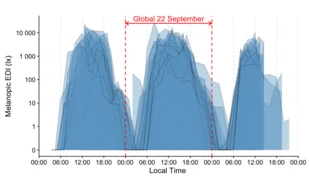How much light reaches people in different regions of the world – and what does this mean for health, well-being, and biological rhythms? These questions form the core of the panel discussion “A Day in Daylight: Light exposure around the world”, taking place on 3 November 2025, from 5:00 to 6:30 p.m CET.
The event is hosted by Prof. Dr. Manuel Spitschan, Head of the Assistant Professorship of Chronobiology & Health. Together with international experts, Spitschan will present new data collected around the autumn equinox on 22 September 2025 – the day when the sun crosses the equator and day and night are nearly equal in length all over the world. The event will be broadcast online via Zoom and is open to researchers, students, and anyone interested in gaining a deeper understanding of the global impact of daylight on humans and the environment.
“We used the autumn equinox to measure real-world light exposure simultaneously in different countries among 48 participants – from Singapore, Ghana, and Turkey to Germany, Norway, and the United States,” explains Prof. Spitschan. “For the first time, we can directly compare how people around the world experience light in their daily lives.”
“For us in Singapore, A Day in Daylight was particularly exciting,” says Dr. Resshaya Murukesu, Postdoctoral Fellow associate in Prof. Spitschan’s group at TUMCREATE, the TUM research platform in Singapore, and co-moderator of the event. “Although we have nearly equal day lengths throughout the year here, many people still spend most of their time indoors.”
The data are analyzed using the open-source software LightLogR, developed by Spitschan’s research group. “With LightLogR, we can reproducibly analyze and compare light exposure data from different sources,” explains Dr. Johannes Zauner, also a Postdoctoral Fellow in Spitschan’s team. “This is crucial for understanding global differences in light environments in a scientifically sound and robust way.”
The results offer insights into the daily lives of diverse populations – from urban centers to rural areas – and provide valuable clues about how light shapes the environment, lifestyle, and health. “What’s particularly fascinating is how cultural and geographical factors influence people’s relationship with light,” says Spitschan. “Everyone has a personal connection to light. This international perspective shows that we need to view the topic within the broader context of global health.”
However, light affects not only societies – it also directly influences human biology. Daylight regulates the so-called circadian rhythm, our internal clock that governs processes such as sleep, metabolism, and cognitive performance. “Our internal clock has its own period, but it’s not exactly 24 hours,” Spitschan explains. “Through daily light exposure and the alternation between light and darkness, it is continually re-synchronized.”
The panel takes place as part of the international Daylight Awareness Week, held from 3 to 7 November 2025, under the theme “Future Solar Societies.” The aim of the awareness week is to strengthen understanding of the diverse roles of daylight in science, culture, and society.
Click here to register for the panel discussion “A Day in Daylight: Light exposure around the world”
Click here for Daylight Awareness Week 2025
To the homepage of the Rudolf Mößbauer Assistant Professorship of Chronobiology & Health
To the homepage of the Translational Sensory and Circadian Neuroscience Unit (MPS/TUM/TUMCREATE)
Contact
Prof. Dr. Manuel Spitschan
Rudolf Mößbauer Assistant Professorship of Chronobiology & Health
Am Olympiacampus 11
80809 Munich
Tel.: +49 89 289 24544
Email: manuel.spitschan(at)tum.de
Text: Bastian Daneyko
Photos: Johannes Zauner / Translational Sensory and Circadian Neuroscience Unit (MPS/TUM/TUMCREATE)



